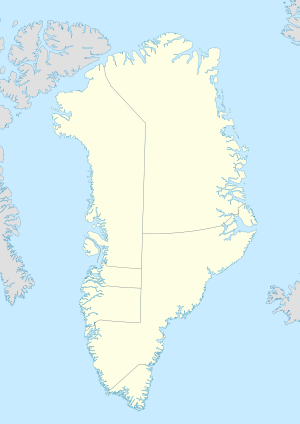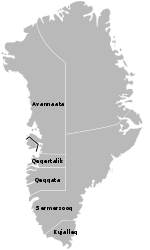Narsarsuaq
Narsarsuaq | |
|---|---|
 Narsarsuaq and Tunulliarfik Fjord | |
| Coordinates: 61°08′45″N 45°26′05″W / 61.14583°N 45.43472°W | |
| State | |
| Constituent country | |
| Municipality | |
| Government | |
| • Mayor | Kiista P. Isaksen |
| Population (2020) | |
• Total | 123 |
| Time zone | UTC−02:00 (Western Greenland Time) |
| • Summer (DST) | UTC−01:00 (Western Greenland Summer Time) |
| Postal code | 3923 |
Narsarsuaq (lit. Great Plain;[2] old spelling: Narssarssuaq) is a settlement in the Kujalleq municipality in southern Greenland. It had 123 inhabitants in 2020.[3] There is a thriving tourism industry in and around Narsarsuaq, whose attractions include a great diversity of wildlife, gemstones, tours to glaciers, and an airfield museum.
History
[edit]
Narsarsuaq is located within the Eastern Settlement of the Greenlandic Norse; the Brattahlíð farm of Erik the Red established in 985 was located on the opposite bank of Tunulliarfik Fjord, where the modern settlement of Qassiarsuk is situated.[2]
In 1941 the United States built an air base at Narsarsuaq code-named Bluie West One (BW1). (Bluie was the Allied military code name for Greenland.) Thousands of planes used BW1 as a stepping stone on their way from the aircraft factories in North America to the battlegrounds of Europe. A 600-bed hospital was built in order to deal with casualties from the Normandy landings.[2] After the end of the war, BW1 continued to be developed, and was a major hospital site during the Korean War, with the military hospital expanded to 1,000 beds.[2] However, it was rendered surplus by the advent of mid-air refueling and the construction of the larger Thule Air Base in northern Greenland. In 1951, it was agreed that Denmark and the United States would jointly oversee the airbase. Although it closed in 1958, it was reopened the following year by the Danish government after the loss of the vessel Hans Hedtoft and all crew south off Cape Farewell.[4] The hospital was destroyed by a fire in 1972, although the ruins remain.
Transport
[edit]Narsarsuaq Airport serves as the principal airfield in southwestern Greenland, with seasonal international flights from Iceland operated by Icelandair. It has also commuter helicopter flights from communities of southern Greenland operated by Air Greenland. Small planes crossing the Atlantic sometimes replicate the North Atlantic Ferry Route, stopping at Narsarsuaq Airport and other World War II airfields, including Goose Bay, Newfoundland in Canada and Reykjavík in Iceland.
Narsarsuaq has a sea port where passenger boats and cruise ships can moor.[5] It is located 2.4 kilometres (1.5 mi) south of the terminal building, so bus transfers are arranged.
A 26 kilometres (16 mi) gravel road is maintained between Qassiarsuk and Narsarsuaq around the fjord. It has two river crossings without bridges but off-road vehicles ford them, although a direct boat across the fjord is also used.[6] There is also a regular boat service to Qaqortoq, 85 kilometres (53 mi; 46 nmi), which takes almost 4 hours.[7]
Population
[edit]The population of the settlement is strictly tied to the traffic dynamics at the local airport.[8]
Climate
[edit]Narsarsuaq experiences boundary subarctic climate (Köppen: Dfc), which with a 1.1 °C (1.98 °F) margin escapes being classified as polar climate that is typical for the rest of Greenland. Despite its rather chilly temperatures, Narsarsuaq is one of the few places in Greenland with abundant naturally growing trees. This is due to several factors. Its geographical position is extremely sheltered from harsh subpolar winds by multiple layers of tall mountains to the west, and there is a heavy oceanic influence that results in a rather stable and steady amount of precipitation year-round. The oceanic influence can be observed in the occasional Atlantic storms that often pound the region (resulting in a fairly wet climate) and a moderate amount of precipitation per year (which could also be considered quite high by Greenlandic standards). Due to the fair climatic conditions, Narsarsuaq is the site of Greenland's only botanical garden, the "Greenlandic Arboretum".
| Climate data for Narsarsuaq, Greenland (1991–2020, extremes 1941–present) | |||||||||||||
|---|---|---|---|---|---|---|---|---|---|---|---|---|---|
| Month | Jan | Feb | Mar | Apr | May | Jun | Jul | Aug | Sep | Oct | Nov | Dec | Year |
| Record high °C (°F) | 14.2 (57.6) |
15.3 (59.5) |
16.5 (61.7) |
19.1 (66.4) |
24.8 (76.6) |
25.2 (77.4) |
24.1 (75.4) |
23.6 (74.5) |
22.4 (72.3) |
18.7 (65.7) |
18.4 (65.1) |
15.9 (60.6) |
25.2 (77.4) |
| Mean daily maximum °C (°F) | −2.1 (28.2) |
−2.6 (27.3) |
−0.7 (30.7) |
4.9 (40.8) |
10.0 (50.0) |
14.0 (57.2) |
15.7 (60.3) |
14.1 (57.4) |
9.9 (49.8) |
5.1 (41.2) |
0.4 (32.7) |
−1.6 (29.1) |
5.6 (42.1) |
| Daily mean °C (°F) | −6.1 (21.0) |
−6.5 (20.3) |
−4.7 (23.5) |
1.3 (34.3) |
5.9 (42.6) |
9.6 (49.3) |
11.1 (52.0) |
9.8 (49.6) |
6.1 (43.0) |
1.5 (34.7) |
−3.3 (26.1) |
−5.5 (22.1) |
1.6 (34.9) |
| Mean daily minimum °C (°F) | −10.5 (13.1) |
−11.1 (12.0) |
−9.1 (15.6) |
−2.6 (27.3) |
1.6 (34.9) |
5.1 (41.2) |
6.7 (44.1) |
5.8 (42.4) |
2.3 (36.1) |
−2.0 (28.4) |
−7.3 (18.9) |
−9.8 (14.4) |
−2.6 (27.4) |
| Record low °C (°F) | −39.7 (−39.5) |
−33.7 (−28.7) |
−31.9 (−25.4) |
−23.1 (−9.6) |
−16.7 (1.9) |
−2.9 (26.8) |
0.1 (32.2) |
−0.1 (31.8) |
−5.7 (21.7) |
−17.8 (0.0) |
−26.1 (−15.0) |
−35.9 (−32.6) |
−39.7 (−39.5) |
| Average precipitation mm (inches) | 40.0 (1.57) |
52.3 (2.06) |
37.1 (1.46) |
44.7 (1.76) |
32.8 (1.29) |
44.8 (1.76) |
49.8 (1.96) |
66.3 (2.61) |
80.2 (3.16) |
56.7 (2.23) |
68.2 (2.69) |
39.5 (1.56) |
612.4 (24.11) |
| Average precipitation days (≥ 0.1 mm) | 10.0 | 8.2 | 9.5 | 10.4 | 8.8 | 11.1 | 12.5 | 10.6 | 11.2 | 9.8 | 9.6 | 10.1 | 122.0 |
| Average snowy days | 9.3 | 7.6 | 8.6 | 7.6 | 2.7 | 0.5 | 0.0 | 0.1 | 1.3 | 5.5 | 7.6 | 8.9 | 59.8 |
| Average relative humidity (%) | 65 | 64 | 66 | 65 | 65 | 69 | 74 | 72 | 69 | 67 | 66 | 65 | 67 |
| Mean monthly sunshine hours | 26 | 65 | 137 | 168 | 177 | 182 | 192 | 156 | 136 | 94 | 44 | 18 | 1,431 |
| Source 1: Danish Meteorological Institute (precipitation days and snowy days 1961–1990 and sunshine 1980–1999)[9][10][11] | |||||||||||||
| Source 2: Météo Climat (records),[12] NOAA (humidity 1961–1990)[13] | |||||||||||||
Greenlandic Arboretum
[edit]


On the lower slopes of the Mellemlandet ridge, close to Narsarsuaq Airport, there is a unique 'botanical garden of the Arctic', called the Greenlandic Arboretum.[14][15] The goal is to establish a live collection of trees and bushes native to both the arctic and the alpine tree-lines of the entire Northern Hemisphere.
Founded in 1988, it encompasses 15 hectares and it shelters 110 plant species, mostly varieties of boreal taiga trees, such as Siberian larch, lodgepole pine, white spruce, Sitka spruce,[16][17] and various bushes. Many individual trees are tagged or otherwise marked. The plantation currently has more than 50,000 trees of various provenances.
References
[edit]- ^ Kujalleq Municipality (in Danish)
- ^ a b c d Facts and History of Narsarsuaq, Narsarsuad Tourist Information
- ^ "Population by Localities". Statistical Greenland.
- ^ Dan Ford. "Remembering Bluie West One". WarbirdForum.com. Retrieved May 9, 2011.
- ^ Narsarsuaq phot by Søren Møller
- ^ Road distance
- ^ "Disko Line".
- ^ a b "Statistics Greenland" (in Danish). Statistics Greenland. Archived from the original on August 12, 2011. Retrieved May 9, 2011.
- ^ "Klimanormaler Grønland". DMI (in Danish). Retrieved 2023-02-28.
- ^ "DMI Report 18–19: Climatological Standard Normals 1981–2010 Denmark, The Faroe Islands and Greenland Based on Data Published in DMI Reports 18–08, 18–04 and 18–05" (PDF). Danish Meteorological Institute. Archived from the original (PDF) on 10 February 2019. Retrieved 10 October 2019.
- ^ "The Observed Climate of Greenland, 1958–99 with Climatological Standard Normals, 1961–90" (PDF). Danish Meteorological Institute. Retrieved 10 October 2019.
- ^ "Station Narsarsuaq" (in French). Météo Climat. Retrieved 10 October 2019.[permanent dead link]
- ^ "Narsarsuaq Climate Normals 1961–1990". National Oceanic and Atmospheric Administration. Retrieved 13 October 2019.
- ^ "History of the Greenlandic Arboretum". Department of Geosciences and Natural Resource Management, University of Copenhagen. 18 October 2013. Retrieved 31 August 2016.
- ^ Location 61°9′29″N 45°25′10″W / 61.15806°N 45.41944°W
- ^ "The Greenlandic Arboretum in Narsarsuaq". Department of Geosciences and Natural Resource Management, University of Copenhagen. 2 August 2013. Retrieved 31 August 2016.
- ^ "The Forest Plantations in The Greenlandic Arboretum". Department of Geosciences and Natural Resource Management, University of Copenhagen. 18 October 2013. Retrieved 31 August 2016.



